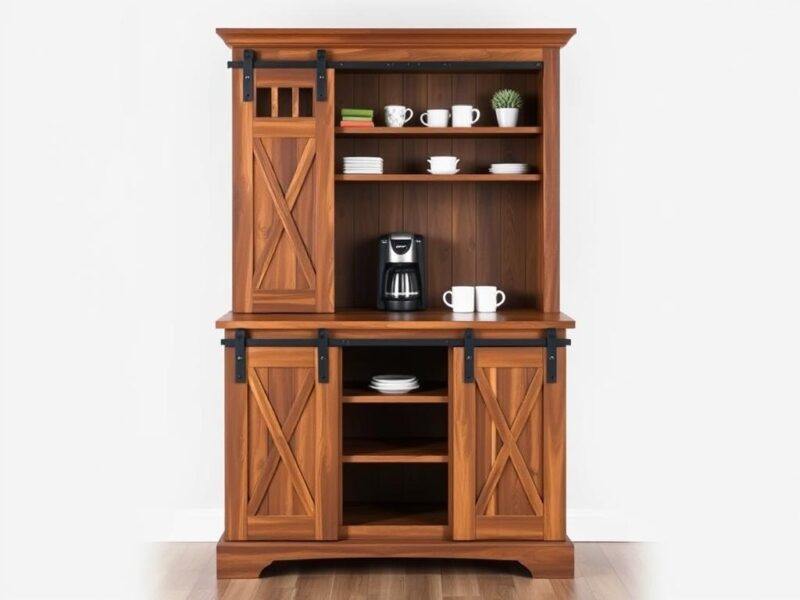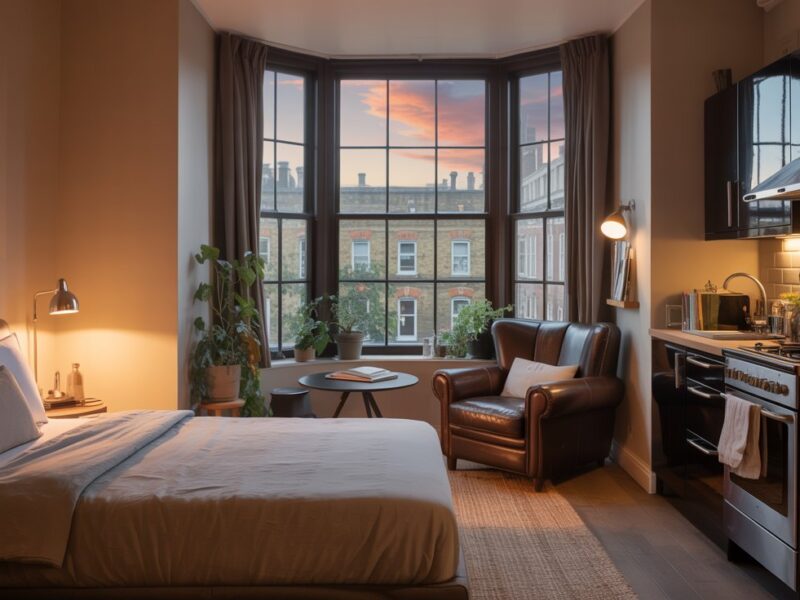A small living room doesn’t mean you have to compromise on style or functionality. In fact, limited square footage can inspire creative solutions that make your space feel both larger and more inviting. Interior designers consistently prove that with the right approach, even the tiniest living rooms can become stylish, comfortable retreats. Whether you’re working with an apartment, condo, or small home, these expert-approved ideas will help you transform your compact space into a room that feels spacious, functional, and undeniably chic.
1. Lighten Up: Create an Airy Atmosphere
One of the most effective small living room ideas is to create a light, airy atmosphere that visually expands your space. “Light colors reflect rather than absorb light, making a room feel more open,” explains interior designer Kate Diaz. “This simple change can dramatically transform how spacious a room feels.”
Best Light Paint Colors for Small Spaces
- Swiss Coffee by Benjamin Moore – a warm off-white that creates depth
- Decorator’s White by Benjamin Moore – a crisp, clean white
- Pale Oak by Benjamin Moore – a soft, neutral beige
- Skylight by Farrow & Ball – a subtle, airy blue-gray
Mirror Placement Tips
Strategic mirror placement can double your visual space. Position a large mirror directly across from a window to reflect natural light throughout the room. For maximum impact, choose a floor-to-ceiling mirror or create a gallery of smaller mirrors on your largest wall.
“When working with small living rooms, I always recommend hanging mirrors at eye level opposite windows. This creates the illusion of another ‘window’ and makes the space feel twice as large.”
2. Furniture That Multitasks: Space-Saving Solutions

In small spaces, every piece of furniture should earn its keep. Multifunctional pieces not only save space but also add versatility to your living area. The key is selecting furniture that serves multiple purposes without overwhelming the room.
Top Multifunctional Furniture Picks
Storage Ottomans
These versatile pieces function as seating, footrests, coffee tables, and hidden storage. Look for ottomans with removable tops and deep storage compartments for maximum utility.
Nesting Tables
These space-saving tables can be spread out when entertaining and tucked away when not in use. They’re perfect for small living rooms where flexibility is essential.
Sleeper Sofas
Modern sleeper sofas have come a long way in comfort and style. They’re ideal for small living rooms that need to double as guest rooms occasionally.
Wall-Mounted Desks
If your living room needs to function as a workspace, consider a fold-down desk that can be tucked away when not in use.
Before & After Transformation: A cramped living room with bulky furniture and limited floor space was transformed by replacing a traditional coffee table and side tables with nesting tables and a storage ottoman. The result? The same functionality with 30% more usable floor space.
3. Look Up for Storage: Maximize Vertical Space
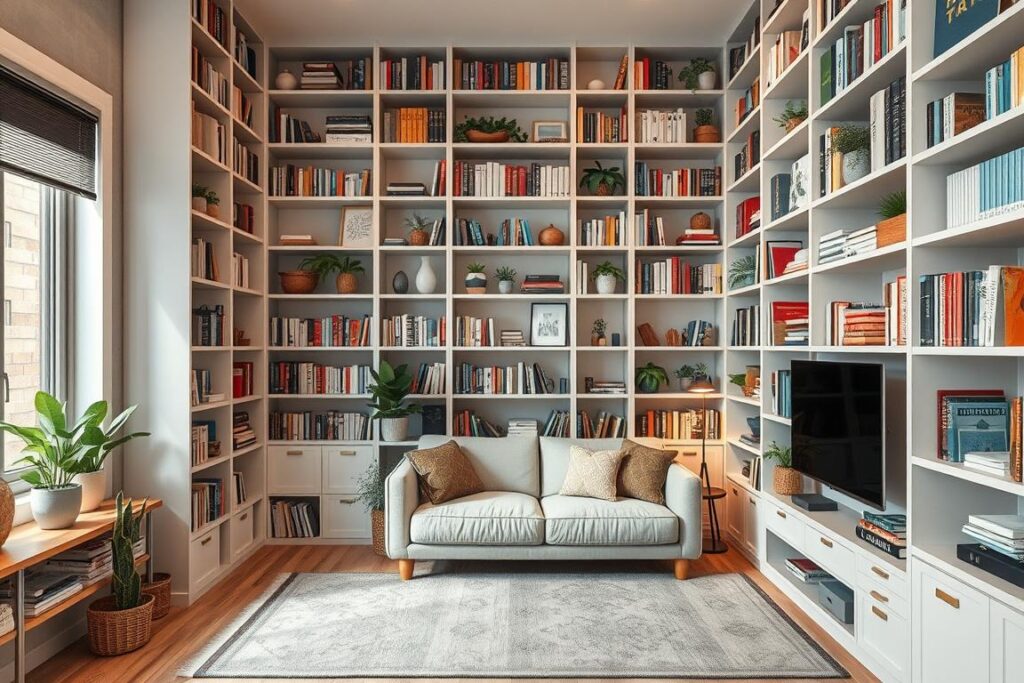
When floor space is limited, the key to making a small living room feel bigger is to utilize your vertical space. Drawing the eye upward creates the illusion of height while providing practical storage solutions that keep your space clutter-free.
Vertical Storage Solutions
- Floor-to-ceiling bookcases that maximize wall space
- Floating shelves arranged in ascending patterns
- Wall-mounted cabinets for concealed storage
- Ladder shelving that creates visual interest
Styling Tips for Vertical Storage
To keep vertical storage from feeling cluttered, follow the 70/30 rule: use 70% of the space for practical storage and 30% for decorative items. Group similar items together, incorporate plants at varying heights, and leave some empty space to allow your display to “breathe.”
“In small living rooms, I always recommend taking storage all the way to the ceiling. It draws the eye up, making ceilings appear higher, while maximizing every inch of available space.”
4. Declutter Like a Pro: Minimize Visual Noise
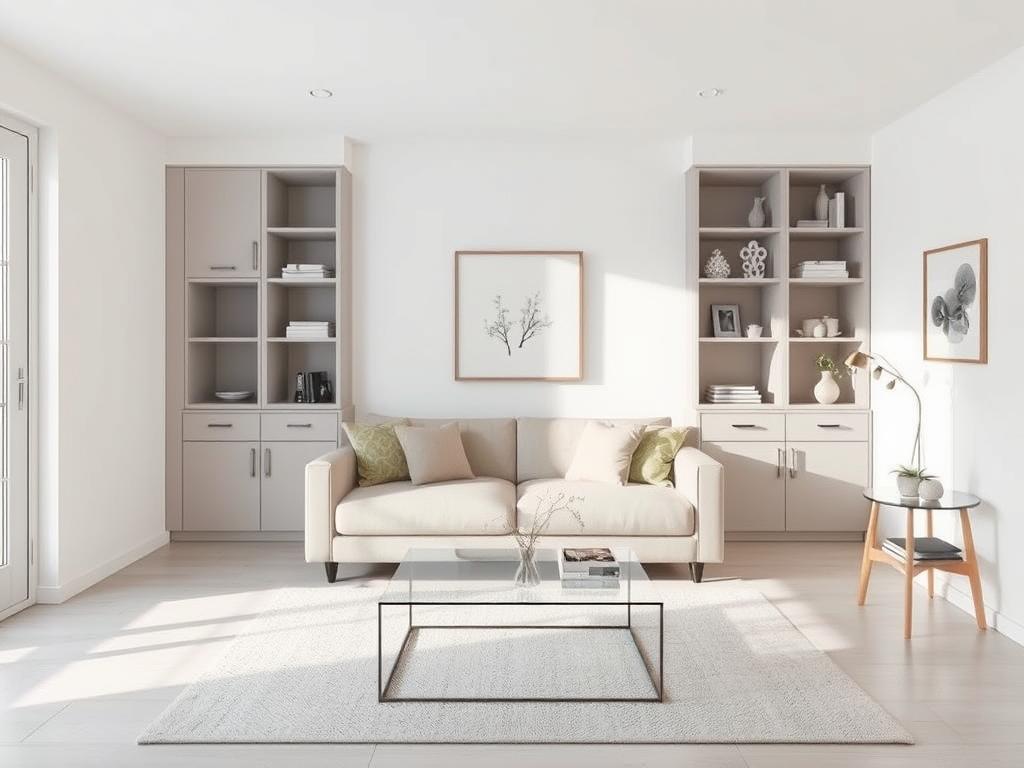
Visual clutter can make even a spacious room feel cramped. In small living rooms, a minimalist approach to decor can dramatically impact how large the space feels. The goal isn’t to eliminate personality but to be intentional about what you display.
Smart Layout Strategies
Zone with Rugs
Define different functional areas within your small living room using appropriately sized rugs. This creates visual organization without physical barriers.
Create Breathing Room
Allow at least 18 inches between furniture pieces to create pathways. This prevents the room from feeling cramped and improves flow.
Hidden Storage Solutions
Incorporate furniture with hidden storage compartments to keep everyday items out of sight. Consider sofas with under-seat storage, coffee tables with drawers, or decorative baskets that blend with your decor.
Designer Tip: Follow the “one in, one out” rule when adding new items to your small living room. For every new decorative piece you bring in, remove one existing item to maintain visual balance.
5. Elevate with Style: Luxe Touches for Small Spaces

Small living rooms can still make a big style statement. In fact, limited square footage allows you to invest in higher-quality materials and statement pieces that might be cost-prohibitive in larger spaces. The key is choosing elements that add visual interest without overwhelming the room.
Texture and Material Mix
- Velvet pillows or accent chairs add luxurious depth
- Metallic accents like brass or copper catch and reflect light
- Natural materials like wood and rattan add warmth
- Glass and lucite pieces create visual lightness
Statement Rug Guidelines
A well-chosen rug can define your space and add personality. For small living rooms, follow these size guidelines:
- 8′ x 10′ for rooms approximately 10′ x 12′
- 5′ x 8′ for rooms approximately 8′ x 10′
- Leave 12-18 inches of floor visible around the perimeter
“Small spaces are perfect for statement pieces. When you have less room, each item has more impact, so choose pieces you truly love rather than playing it safe.”
6. Mind Your Scale: Right-Sized Furniture Selection
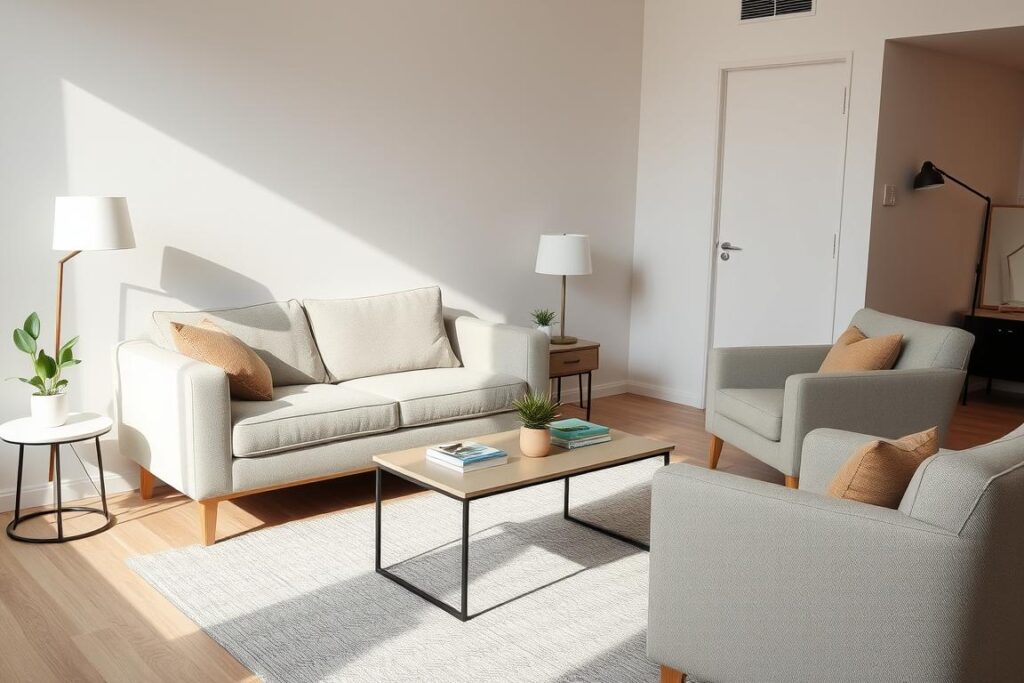
One of the biggest mistakes in small living room design is choosing furniture that’s too large for the space. Properly scaled pieces can make your room feel more spacious while still providing comfort and functionality.
Furniture Sizing Guidelines
Sofas
Look for “apartment-sized” sofas that are typically 72-84 inches wide instead of standard 84-96 inch models. Choose styles with exposed legs to create visual space underneath.
Coffee Tables
Select tables that are approximately two-thirds the length of your sofa. Round or oval shapes prevent sharp corners that interrupt flow in tight spaces.
Space-Saving Alternatives
Consider these alternatives to traditional furniture pieces:
- Swap a traditional coffee table for a set of nesting tables
- Use floor poufs instead of bulky ottomans
- Choose armless accent chairs to reduce visual weight
- Select a loveseat instead of a full-sized sofa
Before & After Transformation: A small living room with an oversized sectional and bulky coffee table was reimagined with an apartment-sized sofa and slim console. The result was a room that felt twice as spacious while maintaining comfortable seating for four people.
7. Layer Your Lighting: Create Depth and Ambiance

Strategic lighting can make a small living room feel larger and more inviting. By incorporating multiple light sources at different heights, you create depth and dimension that expands the perceived size of your space.
The Three Layers of Lighting
Ambient Lighting
Provides overall illumination through ceiling fixtures, recessed lights, or pendants. Choose fixtures with dimmers to adjust brightness levels.
Task Lighting
Focused light for specific activities like reading or working. Table lamps, floor lamps, and adjustable sconces are perfect options.
Accent Lighting
Highlights architectural features or decor. Consider picture lights, LED strips behind furniture, or small uplights.
Space-Saving Lighting Solutions
- Wall sconces instead of table lamps to free up surface space
- Pendant lights instead of floor lamps to save floor space
- Multi-arm floor lamps that provide directional light to multiple areas
- LED strip lighting under shelves or cabinets for ambient glow
Designer Tip: Position mirrors strategically to reflect and amplify your lighting. This creates the illusion of more light sources and makes your space feel larger.
8. Strategic Color: Create Visual Flow
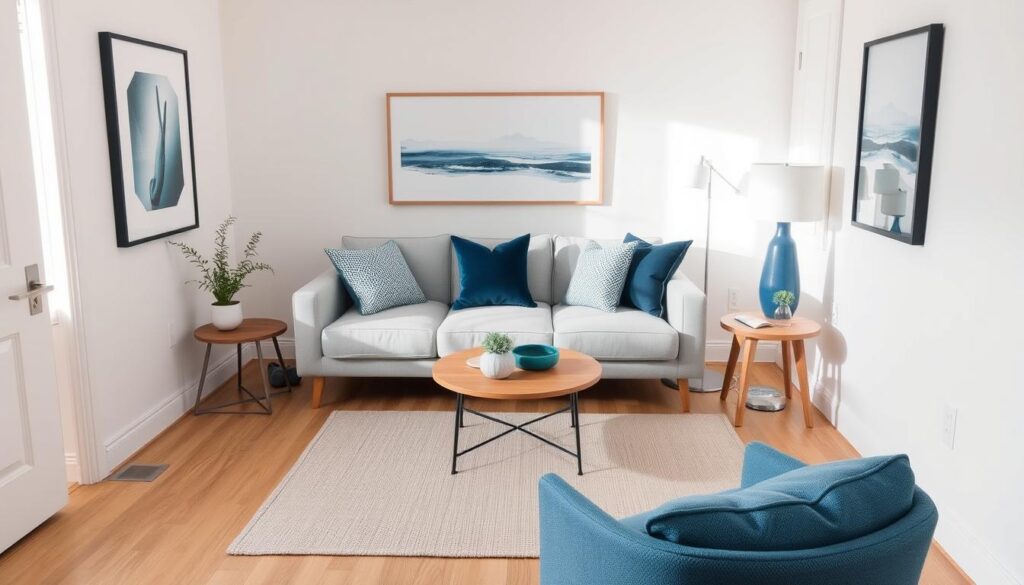
Color has a profound impact on how we perceive space. In small living rooms, a strategic approach to color can create visual continuity that makes the room feel larger and more cohesive.
Color Strategies for Small Spaces
Monochromatic Scheme
Using different shades of the same color creates depth without visual interruption. This approach is particularly effective with neutrals like beige, gray, or soft blue.
Tonal Approach
Select colors with similar undertones to create a harmonious flow. This allows for more variety while maintaining visual cohesion.
Strategic Accent Colors
Rather than scattering multiple accent colors throughout your space, choose one or two bold hues and use them consistently. This creates intentional focal points without visual chaos.
“In small spaces, I recommend the 60-30-10 rule: 60% dominant color (usually a neutral), 30% secondary color, and 10% accent color. This creates balance while allowing for personality.”
9. Smart Furniture Arrangement: Optimize Flow
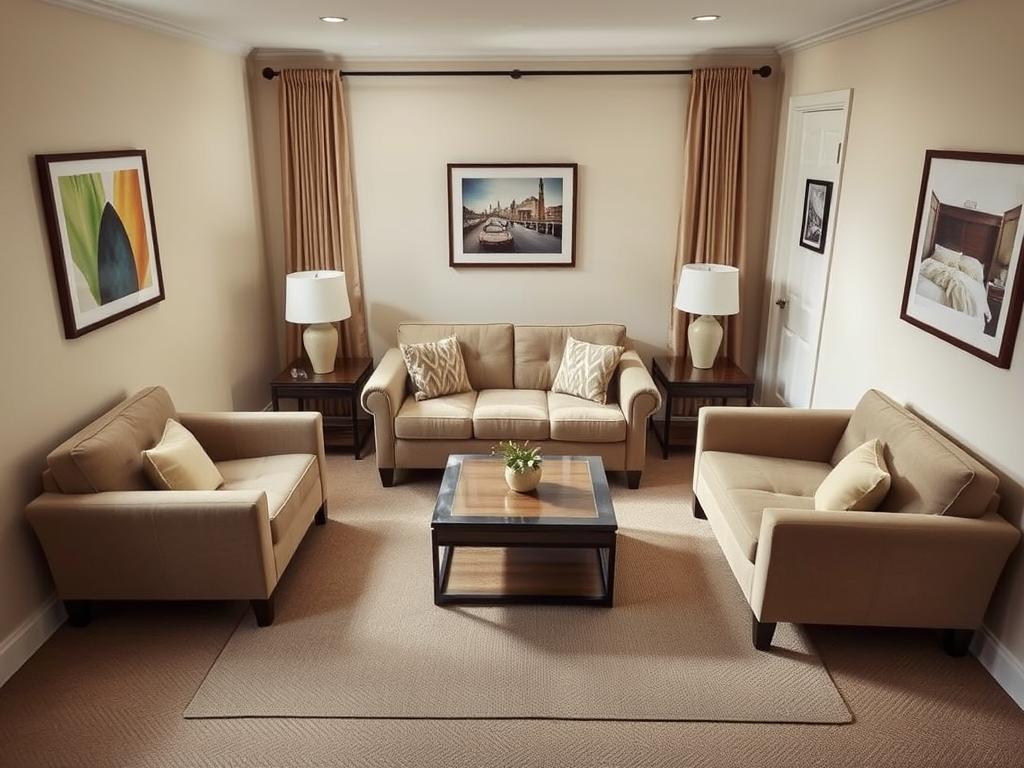
The way you arrange furniture in a small living room can dramatically impact how spacious it feels. Strategic placement creates clear pathways, improves functionality, and enhances the room’s visual flow.
Layout Principles for Small Spaces
- Pull furniture slightly away from walls to create the illusion of more space
- Arrange seating to face each other for better conversation flow
- Create clear pathways of at least 30 inches for comfortable movement
- Avoid blocking windows or natural light sources with tall furniture
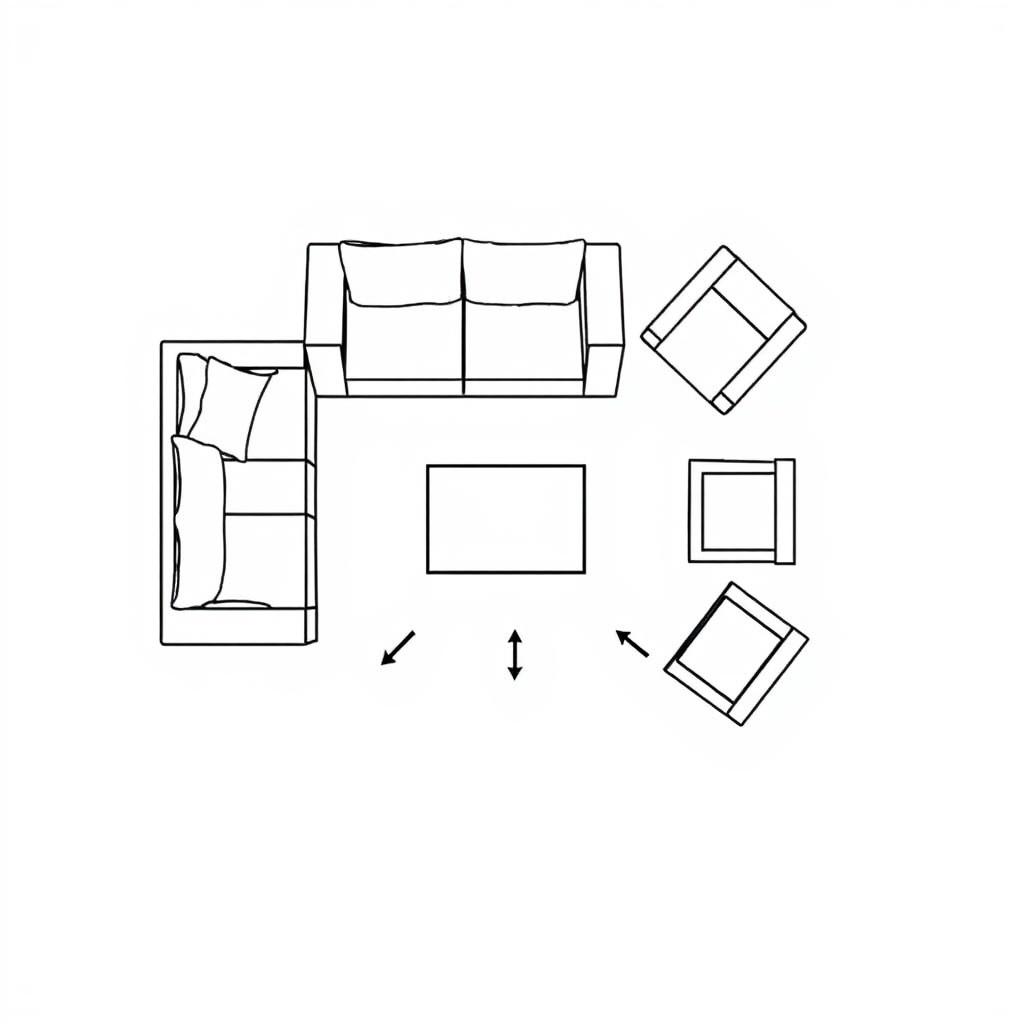
Conversation-Friendly Arrangements
Create intimate conversation areas by positioning seating no more than 8 feet apart. This not only facilitates better interaction but also helps define the living area in open-concept spaces.
Designer Tip: In extremely small spaces, consider a single loveseat with one accent chair instead of a full sofa set. Position them at a right angle to create an L-shaped arrangement that maximizes corner space.
10. Mirror Magic: Create Visual Illusions
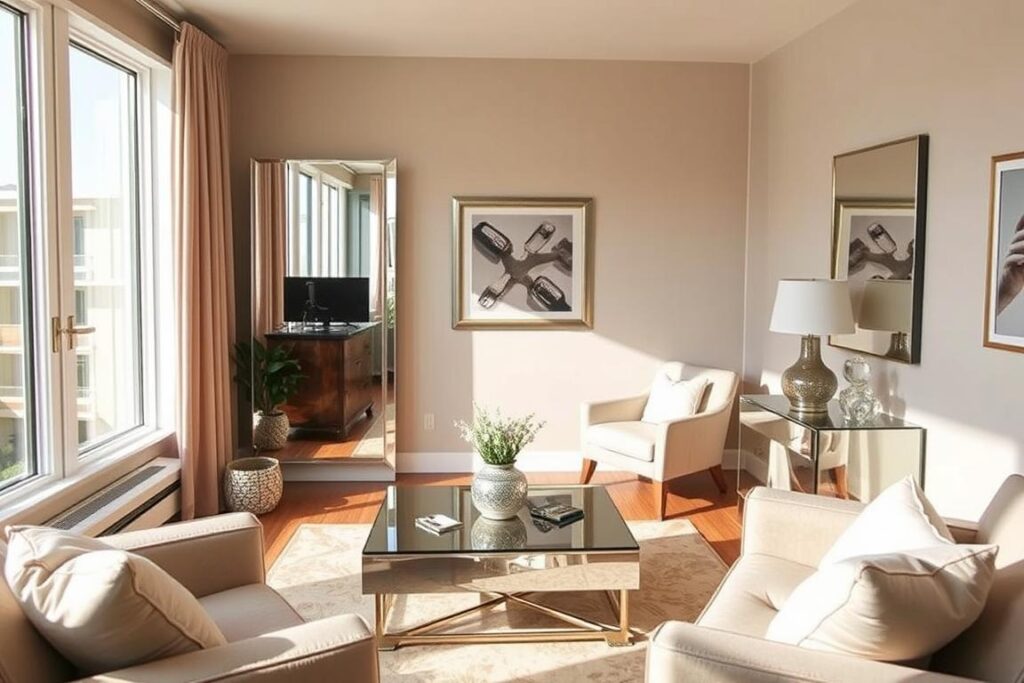
Mirrors are perhaps the most powerful tool for visually expanding a small living room. When strategically placed, they reflect light, views, and space, creating the illusion that your room extends beyond its actual boundaries.
Mirror Placement Strategies
Reflect the View
Position a large mirror to reflect an outdoor view or an attractive part of your room. This creates the illusion of having another “window” or extended space.
Create the Infinity Effect
Place mirrors on opposite walls to create an endless reflection that visually expands your space in multiple directions.
Mirror Styles for Small Spaces
- Floor-to-ceiling mirrors for maximum impact
- Mirrored furniture pieces like coffee tables or console tables
- Gallery walls of smaller decorative mirrors
- Mirrored cabinet fronts for functional storage with visual expansion
Before & After Transformation: A dark, cramped living room corner was transformed by adding a large arched mirror that reflects the window opposite. The result is a space that appears twice as large and significantly brighter throughout the day.
Transform Your Small Living Room Today

Small living rooms present unique challenges, but with these designer-approved strategies, you can create a space that feels both spacious and stylish. Remember that in compact spaces, every design decision matters—from your color palette and furniture selection to lighting and accessory choices.
The most successful small living rooms balance functionality with aesthetic appeal, making thoughtful use of every square inch without sacrificing comfort or style. By implementing these ideas, you’ll not only maximize your space but also create a living room that truly reflects your personal style.
Ready to Transform Your Small Living Room?
Try these space-savvy tips and turn your tiny living room into a stylish retreat—no renovation needed. Start with one strategy at a time, and watch as your space is transformed.

